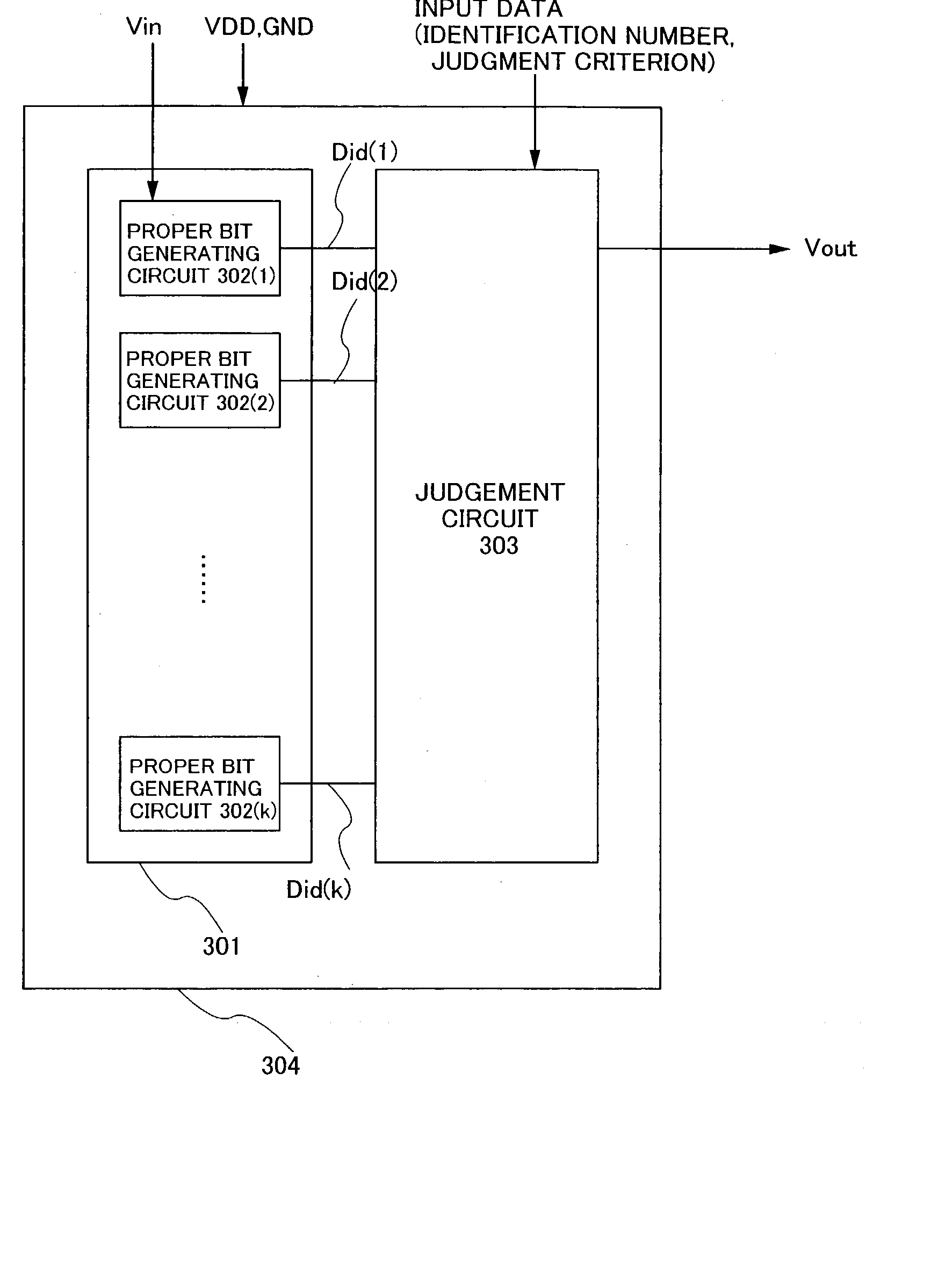Substrate identification circuit and semiconductor device
a technology of identification circuit and substrate, applied in the direction of identification means, instruments, optics, etc., can solve the problems of increasing cost, time and effort, and difficulty in selectively giving a right to the tft substrate, and achieving the effect of reducing the number of chips, and improving the number of chips
- Summary
- Abstract
- Description
- Claims
- Application Information
AI Technical Summary
Benefits of technology
Problems solved by technology
Method used
Image
Examples
first embodiment
[0107] [First Embodiment]
[0108] In this embodiment, there will be described a concrete circuit construction of the proper bit generating circuit described in the embodiment mode. The following description will be made with reference to FIG. 6.
[0109] The proper bit generating circuit shown in FIG. 6 receives input of potentials Vin1 and Vin2 and outputs a proper bit Did. In FIG. 6, the drain region of an N-channel type TFT 602 and the drain region of a P-channel type TFT 604 are connected to each other at a node A, while the drain region of the N-channel type TFT 603 and the drain region of the P-channel type TFT 605 are connected to each other at a node B. The source region of the N-channel type TFT 602 and the source region of the N-channel type TFT 603 are connected to each other and are connected to a constant current source. The source region of the P-channel type TFT 604 and the source region of the P-channel type TFT 605 are connected to each other and are connected to a power...
second embodiment
[0116] [Second Embodiment]
[0117] In this embodiment, as a concrete circuit construction of the proper bit generating circuit, there will be described an example that is different from that in the first embodiment. The following description will be made with reference to, FIG. 7.
[0118] The proper bit generating circuit shown in FIG. 7 receives input of potentials Vin1 and Vin2 and outputs a proper bit Did. In FIG. 7, the drain region of an N-channel type TFT 701 and the drain region of a P-channel type TFT 702 are connected to each other at a node C. The node C is connected to the input terminal of an inverter 703 and this inverter 703 is connected to another inverter 704 in series. The inputs Vin1 and Vin2 into the proper bit generating circuit are respectively connected to the gate electrode of the P-channel type TFT 702 and the gate electrode of the N-channel type TFT 701, and the proper bit Did that is an output from the proper bit generating circuit is connected to the output te...
third embodiment
[0125] [Third Embodiment]
[0126] In this embodiment, as a concrete circuit construction of the proper word generating circuit, there will be described an example that is different from that in the embodiment mode. The following description will be made with reference to FIG. 8.
[0127] In FIG. 8, there is shown a proper word generating circuit that receives input of potentials Vin1 and Vin2 and outputs a k-bit (k is an integer at least equal to one) proper word (Did(1), . . . , Did)k). The proper word generating circuit shown in FIG. 8 is constructed from a reference voltage generating circuit 802 and k proper bit generating circuits 801(1) to 801(k). The k proper bit generating circuits 801(1) to 801(k) are each constructed from a pair of an N-channel type TFT and a P-channel type TFT [805(1), 806(1)] to [805(k), 806(k)], and the circuit construction thereof is identical to the construction shown in FIG. 7 from which the inverters 703 and 704 are removed. Also, the operation thereof i...
PUM
| Property | Measurement | Unit |
|---|---|---|
| temperature | aaaaa | aaaaa |
| thickness | aaaaa | aaaaa |
| thickness | aaaaa | aaaaa |
Abstract
Description
Claims
Application Information
 Login to View More
Login to View More - R&D
- Intellectual Property
- Life Sciences
- Materials
- Tech Scout
- Unparalleled Data Quality
- Higher Quality Content
- 60% Fewer Hallucinations
Browse by: Latest US Patents, China's latest patents, Technical Efficacy Thesaurus, Application Domain, Technology Topic, Popular Technical Reports.
© 2025 PatSnap. All rights reserved.Legal|Privacy policy|Modern Slavery Act Transparency Statement|Sitemap|About US| Contact US: help@patsnap.com



